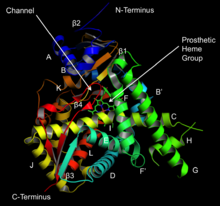Lanosterol 14α-demethylase (CYP51A1) is the animal version of a cytochrome P450 enzyme that is involved in the conversion of lanosterol to 4,4-dimethylcholesta-8(9),14,24-trien-3β-ol.[5] The cytochrome P450 isoenzymes are a conserved group of proteins that serve as key players in the metabolism of organic substances and the biosynthesis of important steroids, lipids, and vitamins in eukaryotes.[6] As a member of this family, lanosterol 14α-demethylase is responsible for an essential step in the biosynthesis of sterols. In particular, this protein catalyzes the removal of the C-14α-methyl group from lanosterol.[6] This demethylation step is regarded as the initial checkpoint in the transformation of lanosterol to other sterols that are widely used within the cell.[6]
| Cytochrome P450, Family 51, Subfamily A, Polypeptide 1 | |||||||
|---|---|---|---|---|---|---|---|
| Identifiers | |||||||
| Symbol | CYP51A1 | ||||||
| Alt. symbols | CYP51, P45014DM | ||||||
| NCBI gene | 1595 | ||||||
| HGNC | 2649 | ||||||
| OMIM | 601637 | ||||||
| RefSeq | NM_000786 | ||||||
| UniProt | Q16850 | ||||||
| Other data | |||||||
| EC number | 1.14.14.154 | ||||||
| Locus | Chr. 7 q21.2-21.3 | ||||||
| |||||||

Evolution
The structural and functional properties of the cytochrome P450 superfamily have been subject to extensive diversification over the course of evolution.[7] Recent estimates indicate that there are currently 10 classes and 267 families of CYP proteins.[8] It is believed that 14α-demethylase or CYP51 diverged early in the cytochrome's evolutionary history and has preserved its function ever since; namely, the removal of the 14α-methyl group from sterol substrates.[7]
Although CYP51's mode of action has been well conserved, the protein's sequence varies considerably between biological kingdoms.[9] CYP51 sequence comparisons between kingdoms reveal only a 22-30% similarity in amino acid composition.[10]
Structure

Although the structure of 14α-demethylase may vary substantially from one organism to the next, sequence alignment analysis reveals that there are six regions in the protein that are highly conserved in eukaryotes.[10] These include residues in the B' helix, B'/C loop, C helix, I helix, K/β1-4 loop, and β-strand 1-4 that are responsible for forming the surface of the substrate binding cavity.[7] Homology modeling reveals that substrates migrate from the surface of the protein to the enzyme's buried active site through a channel that is formed in part by the A' alpha helix and the β4 loop.[11][12] Finally, the active site contains a heme prosthetic group in which the iron is tethered to the sulfur atom on a conserved cysteine residue.[10] This group also binds diatomic oxygen at the sixth coordination site, which is eventually incorporated onto the substrate.[10]
Mechanism

The enzyme-catalyzed demethylation of lanosterol is believed to occur in three steps, each of which requires one molecule of diatomic oxygen and one molecule of NADPH (or some other reducing equivalent).[13] During the first two steps, the 14α-methyl group undergoes typical cytochrome monooxygenation in which one oxygen atom is incorporated by the substrate and the other is reduced to water, resulting in the sterol's conversion to a carboxyalcohol and then a carboxyaldehyde.[10] The aldehyde then departs as formic acid and a double bond is simultaneously introduced to yield the demethylated product.[10]
See also
References
Further reading
- Bak S, Kahn RA, Olsen CE, Halkier BA (February 1997). "Cloning and expression in Escherichia coli of the obtusifoliol 14 alpha-demethylase of Sorghum bicolor (L.) Moench, a cytochrome P450 orthologous to the sterol 14 alpha-demethylases (CYP51) from fungi and mammals". The Plant Journal. 11 (2): 191–201. doi:10.1046/j.1365-313X.1997.11020191.x. PMID 9076987.
- Aoyama Y, Yoshida Y (August 1991). "Different substrate specificities of lanosterol 14a-demethylase (P-45014DM) of Saccharomyces cerevisiae and rat liver for 24-methylene-24,25-dihydrolanosterol and 24,25-dihydrolanosterol". Biochemical and Biophysical Research Communications. 178 (3): 1064–71. doi:10.1016/0006-291X(91)91000-3. PMID 1872829.
- Aoyama Y, Yoshida Y (March 1992). "The 4 beta-methyl group of substrate does not affect the activity of lanosterol 14 alpha-demethylase (P-450(14)DM) of yeast: difference between the substrate recognition by yeast and plant sterol 14 alpha-demethylases". Biochemical and Biophysical Research Communications. 183 (3): 1266–72. doi:10.1016/S0006-291X(05)80327-4. PMID 1567403.
- Alexander K, Akhtar M, Boar RB, McGhie JF, Barton DH (1972). "The removal of the 32-carbon atom as formic acid in cholesterol biosynthesis". Journal of the Chemical Society, Chemical Communications (7): 383. doi:10.1039/C39720000383.
External links
- cytochrome+P-450+CYP51 at the U.S. National Library of Medicine Medical Subject Headings (MeSH)




